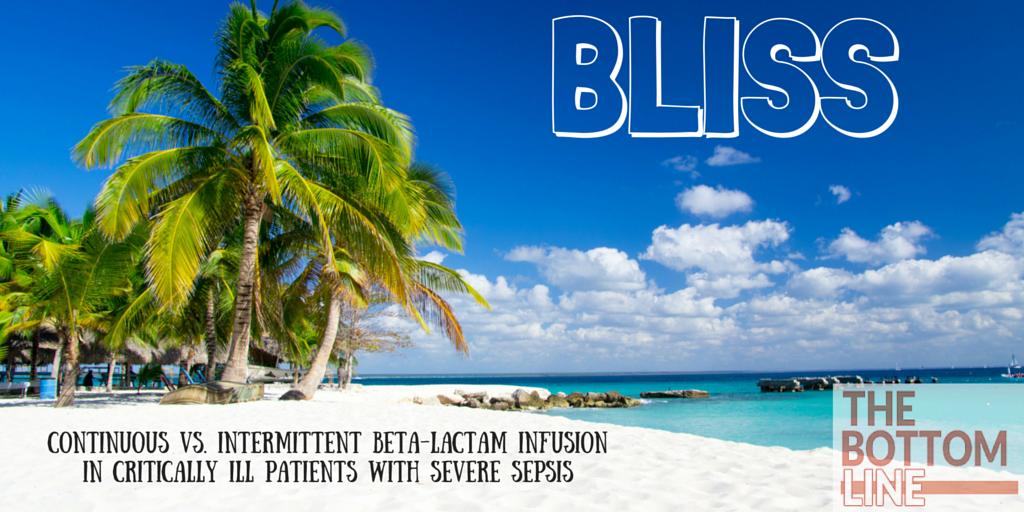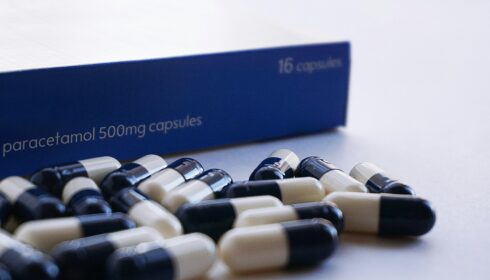BLISS
 A prospective, two-centre, open-labelled randomised controlled trial of continuous versus intermittent beta-lactam infusion in critically ill patients with severe sepsis
A prospective, two-centre, open-labelled randomised controlled trial of continuous versus intermittent beta-lactam infusion in critically ill patients with severe sepsis
Abdul-Aziz. ICM 2016; doi:10.1007//s00134-015-4188-0
Clinical Question
- In adult ICU patients with severe sepsis does the use of continuous infusion (CI) of beta-lactam antibiotics compared to intermittent bolus (IB) improve clinical outcomes?
Design
- Randomised, controlled trial
- Prospective, two-centre, open-labelled
- Computerised block randomisation
- Unblinded staff prepared drugs
- Unblinded staff provided care and management plans
- Blinded investigators assess primary outcome
- Sample size of 120 patients (60 in each group) to demonstrate a statistical significant difference in primary end point assuming 75% and 45% clinical cure rate in intervention and control group.
- Intention-to-treat (ITT) analysis for primary outcome, in addition to:
- Modified intention-to-treat (mITT) conducted in eligible patients who received at least one dose of study drug
- Per protocol analysis of pts who received study drug for > 4 days
Setting
- 2 ICUs in Malaysia
- Recruitment from April 2013 to July 2014
Population
- Inclusion:
- Adult (>18 years)
- Severe sepsis (defined as presumed or confirmed infection with new organ dysfunction) in previous 48 hours
- Indication for cefepime, meropenem or piperacillin/tazobactam with < 24 hr therapy at time of assessment
- Expected ICU stay greater than 48 hrs
- Exclusion:
- Receiving renal replacement therapy
- Impaired hepatic function (total bilirubin > 100umol/ml)
- Patients receiving palliative care
- Inadequate central venous catheter access
- Death was deemed imminent
- 220 patients screened, 140 eligible patients randomised. Main reason for exclusion – renal replacement therapy.
Intervention
- Continuous infusion (CI) of beta-lactam antibiotics
- Loading dose of chosen antibiotic
- Continuous infusion thereafter
- 6gm Cefepime over 24 hours
- 3g Meropenem over 24 hours
- 18g Piperacillin-tazobactam over 24 hours
Control
- Intermittent bolus (IB) of beta-lactam antibiotics
- Loading dose of chosen antibiotic
- Intermittent infusion thereafter
- Cefepime – 2gm every 8 hrs
- Meropenem – 1gm every 8 hrs
- Piperacillin-Tazobactam – 4.5gm every 6 hrs
Management common to both groups
- Antibiotics administered until
- Treating intensivists decided to stop drug
- Pt withdrew from study
- ICU discharge
- ICU death
- All other management plans (including addition of other antibiotics) at discretion of treating intensivists
Outcome
- Characteristics of the groups (CI vs IB)
- APACHE II score: 21 [IQR 17-26] vs 21 [IQR 15-26]
- Pre-randomisation antibiotic therapy: 74% vs 80%
- Median duration of drug treatment: 7 days [IQR 5-9] vs 7 days [IQR 5-9]
- Choice of antibiotic:
- Cefepime: 16% vs 3%
- Meropenem: 30% vs 30%
- Piperacillin-tazobactam: 54% vs 67%
- Concomitant use of antibiotic: 47% in both groups
- No difference in 24hr dose of antibiotics in both groups
- Primary outcome: Higher clinical cure rate at 14 days after antibiotic cessation in CI vs IB
- Continuous infusion: 56%
- Intermittent bolus: 34%
- P-value: 0.011
- Secondary outcome:
- PK/PD target attainment: Significantly higher in CI
- Continuous infusion: 100% fT>MIC 97% on day 3
- Intermittent bolus: 100% fT>MIC 68% on day 3
- ICU-free days at 28 days: No significant difference
- Ventilator-free days at 28 days: Favours CI group
- Continuous infusion: 22 days
- Intermittent bolus: 14 days
- P-value: 0.043
- Survival at 14 days: No significant difference
- Survival at 30 days: No significant difference
- Time to white cell count normalisation: Favours CI group
- Continuous infusion: 3 days
- Intermittent bolus: 8 days
- P-value: <0.001
- PK/PD target attainment: Significantly higher in CI
- Modified-intention-to-treat analysis did not change outcomes
Authors’ Conclusions
- In critically ill patients with severe sepsis not receiving RRT, CI administration was associated with higher clinical cure rates and better PK/PD target attainment compared to IB dosing for three common beta-lactam antibiotics
Strengths
- Inclusion of a pragmatic, heterogenous ICU population
- Pharmacokinetic measurements included as secondary endpoints
Weaknesses
- Unblinded staff deciding management plans although assessors for primary outcome were blinded
- Exclusion of patients requiring renal replacement therapy
- Additional treatment at discretion of treating intensivists; significant use of concomitant antibiotics
- No follow up beyond ICU stay
- Clinical cure rate much lower in both groups compared to that used to power the study
The Bottom Line
- This study confirms that CI has a superior PK/PD profile compared to IB regiments
- The higher clinical cure rate, ventilator free days and faster resolution of white cell count in the CI group did not translate to a mortality benefit at both 14 and 30 days
- Given the weakness in this study and the simplicity of IB regiment, I will continue to use this in my daily practice
External Links
- [article] Beta-Lactam Infusion in Severe Sepsis (BLISS): a prospective, two-centre, open-labelled randomised controlled trial of continuous versus intermittent beta-lactam infusion in critically ill patients with severe sepsis
- [further reading] A multicenter randomized trial of continuous versus intermittent beta-lactam infusions in severe sepsis
- [further reading] Alternative dosing strategies for intravenous antibiotics to treat severe infections
- [further reading] LITFL CCC – Antimicrobial dosing and kill characteristics
Metadata
Summary author: @avkwong
Summary date: 21 January 2016
Peer-review editor: @DuncanChambler




Pingback: Global Intensive Care | Clinical Trials Worth Knowing – CRICU Sepsis Nursing Workshop
Pingback: Clinical Trials Worth Knowing – CRICU Sepsis Nursing Workshop |
Pingback: Clinical Trials Worth Knowing - CRICU Sepsis Nursing Workshop - INJECTABLE ORANGE